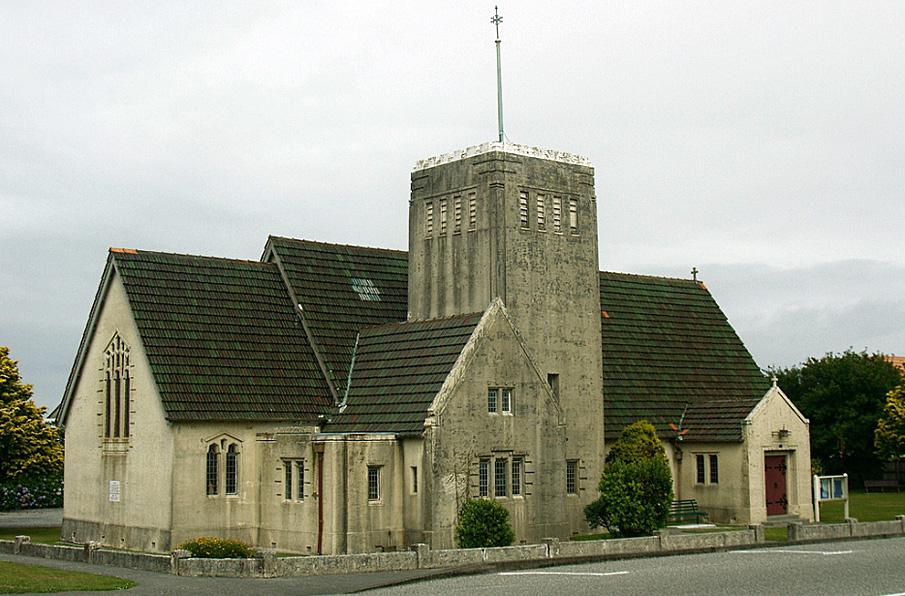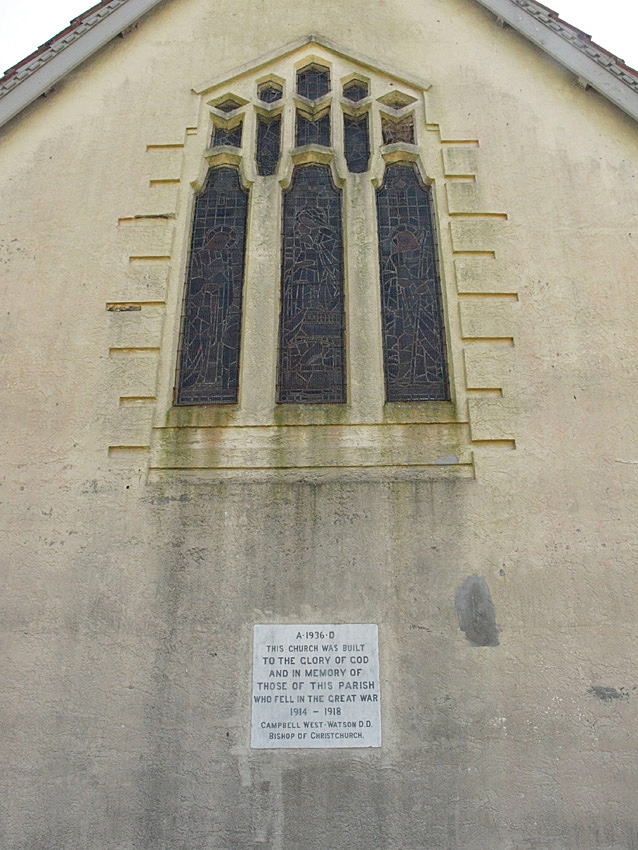All Saints Church (Anglican) in Hokitika was originally conceived as a memorial to members of the congregation who had died during World War I. It replaced an earlier wooden church, which had been erected in 1866 on the Anglican reserve in Fitzherbert Street shortly after Hokitika was established as a result of the West Coast goldrush. By 1919 the congregation of All Saints had established a building fund and asked Invercargill architect Edmund Richardson Wilson (1871-1941) to draw up plans for a suitable new church. Wilson appears to have put forward various plans throughout the 1920s. However, nothing was built and in 1935 the vestry formally dissolved its agreement with Wilson. The church then invited a number of architects to submit proposals, including Christchurch architects Cecil Wood, Roy Lovell-Smith and R.S.D. Harman. The requirements included that the church be built from concrete, that it seat 200 and that it not cost more than £4,000. Both Lovell-Smith and Harman put forward plans and Harman's was accepted. Harman was closely associated with the Anglican Church throughout his career and most of his ecclesiastical work was commissioned by the Anglican dioceses of Canterbury and Nelson. Harman's design for All Saints follows the nineteenth century Ecclesiological dictate that all elements of the church be clearly articulated. His use of undisguised concrete reflects his adherence to the Arts and Crafts principles of honesty in materials. In a letter about his design of All Saints, Harman commented 'With a material such as concrete it is neither feasible nor desirable to imitate exactly features developed in wood or stone. Hence some of the features ... have deviated from tradition'. The use of concrete for churches had been explored in New Zealand during the nineteenth century by architects such as Benjamin Woolfort Mountfort and Francis Petre. In the early twentieth century a number of other architects experimented with the construction of churches in concrete. By the 1930s the use of unadorned concrete had become more acceptable for small churches. (Prior to this concrete tended to be faced with either stone or brick, or scored to imitate stone.) In part this was because concrete was cheaper than brick, an important consideration for small church congregations during the Depression. Reinforced concrete construction had also become increasingly popular in New Zealand after the disastrous Hawke's Bay earthquake of 1931. The successful construction of nearby St Andrew's Presbyterian Church (1935) in reinforced concrete may have influenced the vestry of All Saints to specify concrete as the main construction material. Harman designed All Saints Church with cavity walls 'to ensure the exclusion of dampness', a wise move given the prevailing weather of the Coast. He specified that rimu be used for the roof timbers, joists and flooring. The Oamaru stone font was carved by Frederick Gurnsey, the noted Christchurch carver and is another example of Harman's and Gurnsey's collaborations. Harman's initial plans used cedar shingles for the roof, because of their relative cheapness, and included a spire on the tower. In the event the church decided to forgo the spire in order to roof the building in tiles. Building began in 1936 and the church was consecrated on 1 November 1936. Building of the church was subsidised by the government under the House-building Subsidy Scheme (No. 12). This scheme was one of many established by the Unemployment Board during the 1930s in order to provide work for the thousands of unemployed. It began in July 1934 as a way of encouraging the construction of new dwellings, thus providing employment and dealing with the growing problem of sub-standard housing. By the middle of 1935 the scheme had been extended to cover the erection of 'churches, Sunday schools, public halls, libraries and other buildings' for non-profit organisations. All Saints received the standard ten percent subsidy on the total cost of the church available under this scheme and was probably one of the last to do so as the scheme was terminated in September 1936. All Saints Church in Hokitika is a fine example of a 1930s reinforced concrete church and shows the use of new technology combined with nineteenth century ideals. This led to some simplifying of forms, which appear modern in conception and it is an important example of Harman's adaptability as an architect. Concrete was also a practical choice in terms of its cheapness and relative ease of construction. All Saints Church, in conjunction with St Andrew's Presbyterian Church, has given Hokitika two fine examples of reinforced concrete churches. It is one of only a handful of churches to be built under a Depression subsidy scheme. Today it is still used for Anglican worship.



Location
List Entry Information
Overview
Detailed List Entry
Status
Listed
List Entry Status
Historic Place Category 1
Access
Private/No Public Access
List Number
5012
Date Entered
6th June 1990
Date of Effect
6th June 1990
City/District Council
Westland District
Region
West Coast Region
Extent of List Entry
Extent includes the land described as Lot 3 DP 2480 (RT WS5B/1307), Westland Land District, and the building known as All Saints' Church (Anglican) thereon, and its fittings and fixtures.
Legal description
Lot 3 DP 2480 (RT WS5B/1307), Westland Land District
Stay up to date with Heritage this month
